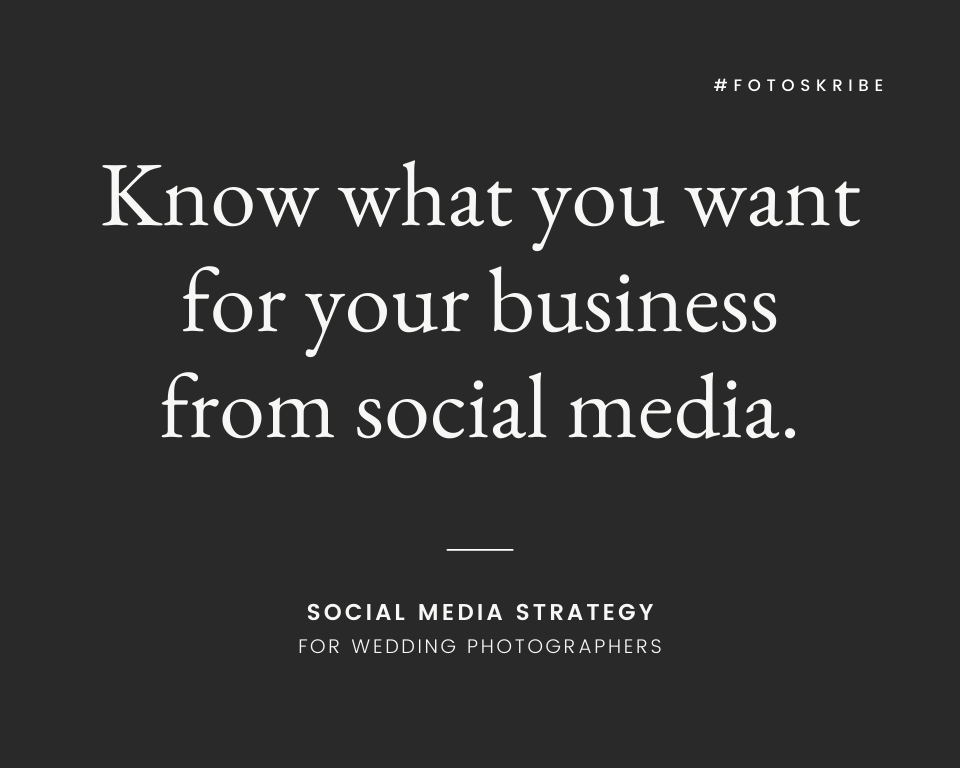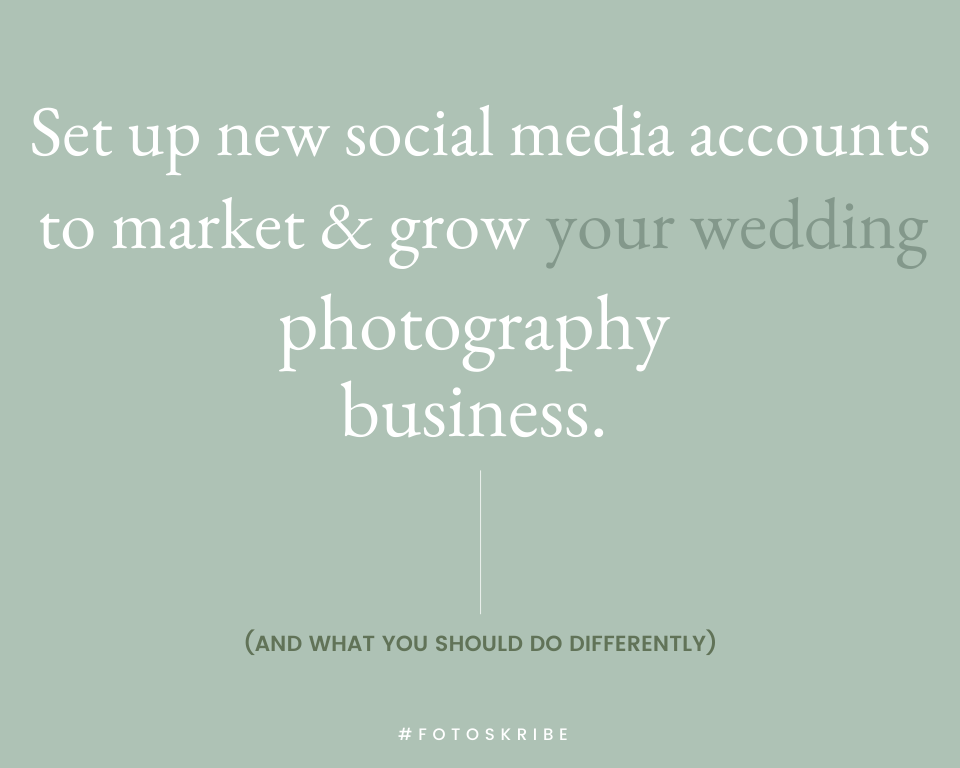Social Media Strategy For Wedding Photographers

“Does my brand have a strong presence on social media platforms?” That’s one of the questions business owners need to be asking themselves in today’s day and time. As a photography business owner, you should too! Because if not, you run the risk of not reaching out to potential clients who are scrolling through various online platforms day in, day out. And to make the most of this promising marketing medium, the two things you need to get right are planning and strategizing. Your social media strategy will comprise your content guidelines, posting frequency, and all about your social media marketing campaigns. In short, it is an outline of everything you want to and plan to achieve on social media. It can also help you keep a tab on your campaigns and make needed improvements. So, if you’re wondering how you can set up a social media strategy for your wedding photography business, we’ve got you covered! Here are some steps to creating a winning social media strategy that could help your brand and business make the right noise on social media.
Steps To Create A Social Media Strategy
1. Set Goals

It’s important that you first know what you aim to do with your social media and how you want it to help your business. Be sure if you want it to increase your brand awareness, build an engaged community, market and sell your products and services, know about what people think about your work and brand, use it as a means of providing customer service, advertise, or just track your campaign impact. Once you know your goal, establish a SMART goal framework. This means your goals will have to be specific, measurable, attainable, relevant, and time-bound to direct you to success and give you the desired return on investment (ROI).
2. Know Your Audience
You might have a killer product, but unless it reaches your target audience, all your hard work might just go to waste. Therefore, the next thing that you need to do to create an excellent social media strategy is to research and get to know your target audience. The age bracket that your target clientele falls in, their educational background, location, average income, the kinds of jobs they hold or the industry they work in, their interests, and the social media accounts they are most active on – these are some of the things that need your close attention. Don’t just stop there! Dig deeper and find out the time when they are most active on social media so that you can reach the maximum number of people through your posts. The more you know your audience, the better you’ll be able to engage with them.
Related Read: Blog Topics For Photographers: 5 Ideas To Engage Your Audience
3. Research About Your Competitors

Knowing your target audience is crucial, but being aware of your competitors is equally important. Research about the overlap in your target audience and the client base that your competitors are eyeing, understand what approach they take in targeting them, and the social media channels they rely on for reaching out to them. Learn a few tricks from your competitors and come up with some of your own ideas to fill any demand and supply gap in the market. You can use all this information to your advantage and use your social media platforms to reach out to your audience in the most impactful way.
4. Conduct A Social Media Audit
If you’ve already been using social media, ask yourself a few questions, such as – has this platform helped your business so far? Is everything you are doing on this platform yielding you the desired results? Is your target audience engaging with you on this platform? Are they more engaged with your competitors than you? Once you have all that information, you’ll be in a position to start thinking about ways to improve your social media marketing techniques. This audit will give you a clear picture of the purpose your various social media accounts are serving you. This is also a good time to weed out any imposter or fake accounts registered against your brand or business name and take appropriate action against those handles.
Related Read: Social Media Marketing Tips For Wedding Photographers
5. Open New Accounts

Once you are through with your social media audit, you will be able to use all the information you have at hand to decide if you should go forward with the platform you’ve been using or get on to a new one to reach out to your target audience. Whether you create new accounts or revamp your existing platforms, ensure that they align with your goals and social media strategy. Fill out all profile fields, include keywords that people might use to look for your business and services, use consistent color schemes, logos, and images to make your profiles easily recognizable across all platforms. Open business accounts and use high-quality visuals to attract and impress your audience.
6. Set Up A Social Media Calendar
If you’ve heard the saying too much or too little of anything is bad, chances are you already know what we’re trying to say here! Posting too much content or too little of it might not be the most ideal way to boost your brand awareness online. While an overdose of content could annoy your audience, posting too little of it can make them lose interest in your posts. And therefore, consistency is key when planning your social media calendar! Create a content schedule or calendar by fixing the days, dates, and times you want your content to go live on different social media platforms such as Facebook, Instagram, LinkedIn, Pinterest, etc. To stay frequent and establish trust in your audience, stick to your schedule. We suggest you post 3-7 times per week on Instagram, 1-2 times per day on Facebook, 1-5 times per day on Twitter and LinkedIn. For scheduling your content, you may use websites such as Hootsuite.
Related Read: How To Build A Content Marketing Roadmap
7. Create Content To Impress

Decide about the kind of content you want to put up on your social media channels. It could be long-form articles, short-format writing, images, audio messages, videos, infographics, or anything else that’s appropriate for your chosen platform. It might take some experimentation and patience over time to find out which type of content works best on which social media platform. So, be ready to keep updating this section in your social media strategy from time to time. Also, revisit your objectives before you start creating content. Make sure it aligns with your vision and strategy and compels your viewers or audience to engage, react, and take actions that impact your business positively.
8. Track Performance & Make Improvements
Document everything from the creation of your strategy to its implementation on social media so that you can keep a tab on your stand-alone posts as well as campaigns and work on improving them later. Track your performance metrics, such as the number of likes, reactions, views, shares, followers, and comments to see if your new strategy is helping you. If yes, try to figure out how they are helping you and to what extent. If not, then get down to investigating what’s going wrong and look for ways to fix it. In short, re-evaluate and rework to get better results.
Further Read: Finding The Right Social Media Tool For Your Business
A social media strategy is actually a framework and not a final document to guide you through your social media usage. It will help you realize what you want and when you can keep taking corrective measures to achieve your goals. So, although our framework is designed to help you move in the right direction, you’d need to keep tracking and improving your posts as well as your strategy as a whole to manage social media and allow it to work for you. So, get started and begin putting it all together for your business!
At Fotoskribe, we aim to help businesses like yours grow their online presence by delivering smart and meaningful content that engages your audience. And we do it in a way that gets Google’s attention.
For more information on how we can help – check out our pricing plans.
